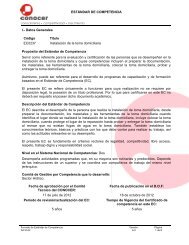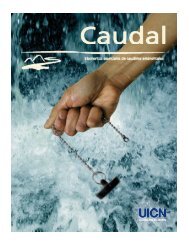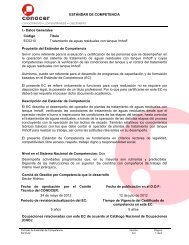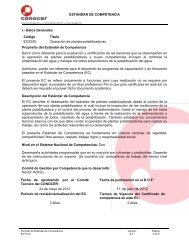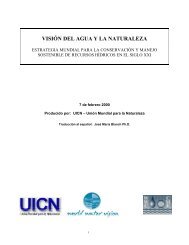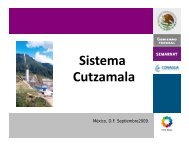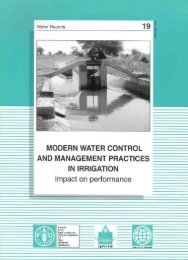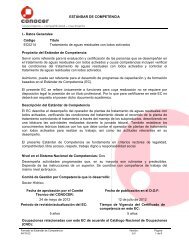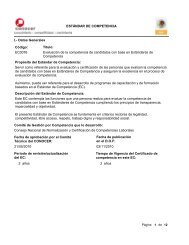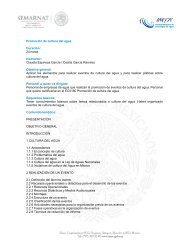Agricultural drainage water management in arid and semi ... - FAO.org
Agricultural drainage water management in arid and semi ... - FAO.org
Agricultural drainage water management in arid and semi ... - FAO.org
Create successful ePaper yourself
Turn your PDF publications into a flip-book with our unique Google optimized e-Paper software.
24Framework for select<strong>in</strong>g, evaluat<strong>in</strong>g <strong>and</strong> assess<strong>in</strong>g the impact of <strong>dra<strong>in</strong>age</strong> <strong>water</strong> <strong>management</strong>TABLE 3Reuse measures, practices <strong>and</strong> po<strong>in</strong>ts for considerationOption Practices Po<strong>in</strong>ts for considerationReuse <strong>in</strong>conventionalagricultureReuse <strong>in</strong> sal<strong>in</strong>eagricultureIFDM SystemReuse <strong>in</strong>wildlife habitats<strong>and</strong> wetl<strong>and</strong>sReuse forreclamation ofsalt-affectedsoilsSource: SJVDIP, 1999a.<strong>Agricultural</strong> <strong>dra<strong>in</strong>age</strong> <strong>water</strong> is collected <strong>and</strong>redistributed among farmers. Reuse canbe direct or <strong>in</strong> conjunction with othersources of irrigation <strong>water</strong>. Conjunctive usecan be through blend<strong>in</strong>g or by cyclic use of<strong>dra<strong>in</strong>age</strong> <strong>water</strong> <strong>and</strong> other sources ofirrigation <strong>water</strong>.Moderately <strong>and</strong> highly sal<strong>in</strong>e <strong>dra<strong>in</strong>age</strong><strong>water</strong> is collected <strong>and</strong> used to cultivate salttolerant shrubs, trees <strong>and</strong> halophytes.On-farm sequential reuse of agricultural<strong>dra<strong>in</strong>age</strong> <strong>water</strong> on crops, trees <strong>and</strong>halophytes with <strong>in</strong>creas<strong>in</strong>g salt tolerance.In every reuse cycle the volume of<strong>dra<strong>in</strong>age</strong> <strong>water</strong> decreases while the saltconcentration <strong>in</strong>creases. The f<strong>in</strong>al br<strong>in</strong>e isdisposed <strong>in</strong> a solar evaporator. Saltutilization might be feasible.Where of suitable quality, <strong>dra<strong>in</strong>age</strong> <strong>water</strong>may be utilized to support wildlife, <strong>in</strong>clud<strong>in</strong>g<strong>water</strong>birds, fish, mammals <strong>and</strong> aquaticvegetation that serves as food <strong>and</strong> coverfor wildlife.Use of (moderately) sal<strong>in</strong>e <strong>dra<strong>in</strong>age</strong> <strong>water</strong>for <strong>in</strong>itial reclamation of sal<strong>in</strong>e, sal<strong>in</strong>e sodicor sodic soils. On sodic soils the sal<strong>in</strong>e<strong>water</strong> may help prevent soil dispersion <strong>and</strong>degradation of soil structure.The extent of reuse depends on the quality of the<strong>dra<strong>in</strong>age</strong> effluent, time of availability, croptolerance, etc. Soil quality degradation <strong>and</strong>production losses need to be prevented throughmitigation measures. Residuals of reused<strong>water</strong>s, which are often highly concentrated witha reduced volume, need to be managed.Susta<strong>in</strong>ability of the sal<strong>in</strong>e agricultural systemsneeds to be safeguarded while the highlyconcentrated <strong>dra<strong>in</strong>age</strong> effluent needs to bemanaged.To ma<strong>in</strong>ta<strong>in</strong> adequate control of soil sal<strong>in</strong>ity <strong>and</strong>sodicity <strong>and</strong> to prevent a buildup of toxicelements, the leach<strong>in</strong>g fraction must besufficient. The solar evaporator should bedesigned <strong>in</strong> such a manner that it will not susta<strong>in</strong>aquatic life <strong>and</strong> attract birds. The salts have tobe disposed of <strong>in</strong> a safe <strong>and</strong> susta<strong>in</strong>ablemanner.Of primary concern is the possible presence oftrace elements that may be toxic to wildlifethrough bioaccumulation <strong>in</strong> the food cha<strong>in</strong> e.g.selenium, molybdenum <strong>and</strong> mercury.Once <strong>in</strong>itial reclamation is obta<strong>in</strong>ed, <strong>water</strong> ofsufficient quality <strong>and</strong> quantity needs to beavailable for desired l<strong>and</strong> use. Initially, the<strong>dra<strong>in</strong>age</strong> effluent will be highly sal<strong>in</strong>e <strong>and</strong>/orsodic <strong>and</strong> needs to be disposed of <strong>in</strong> a safemanner.<strong>in</strong>itial reclamation of salt-affected l<strong>and</strong>s (SJVDIP, 1999a). Table 3 provides a brief descriptionof the alternative reuse measures.Reuse measures can be implemented <strong>in</strong> comb<strong>in</strong>ation with conservation measures. Wherethe <strong>dra<strong>in</strong>age</strong> <strong>water</strong> is of relatively good quality, its reuse potential <strong>in</strong> conventional agriculture ishigh. Where it is moderately to highly sal<strong>in</strong>e, its reuse may be limited to salt tolerant plants. InCalifornia, the United States of America, a new IFDM system reuses <strong>dra<strong>in</strong>age</strong> <strong>water</strong> sequentially<strong>in</strong> high <strong>water</strong> table l<strong>and</strong>s with no opportunities for disposal of subsurface <strong>dra<strong>in</strong>age</strong> (SJVDIP,1999a). Fresh<strong>water</strong> is used to grow salt sensitive crops, <strong>and</strong> subsurface <strong>dra<strong>in</strong>age</strong> <strong>water</strong> from itis reused to grow salt tolerant crops. Dra<strong>in</strong>age <strong>water</strong> from the salt tolerant cropl<strong>and</strong> is used toirrigate salt tolerant grasses <strong>and</strong> halophytes. When the <strong>dra<strong>in</strong>age</strong> <strong>water</strong> is no longer usable, it isdisposed <strong>in</strong>to solar evaporators for salt harvest. In this system <strong>and</strong> others, it is always necessaryto generate a m<strong>in</strong>imum volume of <strong>dra<strong>in</strong>age</strong> effluent to prevent the rootzone from becom<strong>in</strong>g toocontam<strong>in</strong>ated for any beneficial <strong>water</strong> use activity. Similar systems are be<strong>in</strong>g developed <strong>and</strong>tested <strong>in</strong> Australia.Treatment measuresDra<strong>in</strong>age <strong>water</strong> treatment <strong>in</strong> a <strong>dra<strong>in</strong>age</strong> <strong>water</strong> <strong>management</strong> plan normally takes place onlyunder severe constra<strong>in</strong>ts, such as str<strong>in</strong>gent regulations on disposal of sal<strong>in</strong>e <strong>dra<strong>in</strong>age</strong> <strong>water</strong>s <strong>in</strong>tostreams, or severe <strong>water</strong> shortage. The <strong>dra<strong>in</strong>age</strong> <strong>water</strong> treatment options are based on physical,chemical <strong>and</strong>/or biological processes (SJVDIP, 1999b). Many of these processes are borrowed



